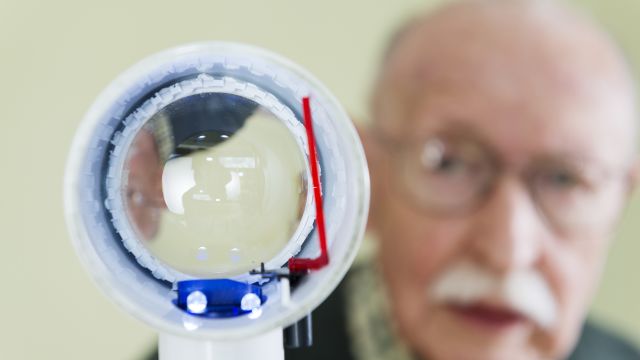Age-related macular degeneration (AMD) is a chronic and progressive eye disease that affects the macula. The macula is a layer of light sensitive cells in the back of the eyeball that enables central vision. A person depends on central vision to see details, read, recognize faces, and perform many daily tasks.
Wet AMD is a type of AMD that occurs when abnormal blood vessels form underneath the macula. These blood vessels do not function well, and leak fluid and blood that can damage the retina. This type of AMD can progress quickly and cause severe vision loss if left untreated. However, it’s uncommon for AMD to result in total blindness—while central vision is impaired, peripheral vision remains, and can be used.
Treatment for wet AMD
There is no cure for wet AMD, but there are several treatments that can help slow the progression of the disease and protect a person’s remaining vision.
Anti-VEGF medications are the most common approach to treatment. These medications are injected into the eyeball and act on the abnormal blood vessels, reducing the leakage of blood and fluid. This gives the eyeball an opportunity to clear away accumulated leakage and helps prevent further damage to the macula. While the idea of receiving an injection into the eyeball can be intimidating, the procedure is typically painless, takes only seconds, and requires only a short visit to the eye doctor’s office.
Another treatment option is photodynamic therapy, which uses a combination of injections and lasers to seal or destroy abnormal blood vessels.
Vision rehabilitation
Even with effective treatment, people with wet AMD often experience some degree of vision loss or impairment. Vision loss refers to a reduction in vision that cannot be fully corrected with glasses or treatment.
In addition to treatment, a person with wet AMD should consider vision rehabilitation. Also called low vision rehabilitation, vision rehabilitation is a personalized program that aims to maximize the use of remaining vision and improve quality of life.
The goals of vision rehabilitation will vary from person to person, and a program will be designed to help a person with what they want and need to do, and what they are finding challenging or difficult. Goals can include improving reading and writing ability, orientation and mobility, safety, independence, and mental and emotional wellbeing.
A comprehensive vision rehabilitation program may include a combination of the following:
- Low vision aids and devices, such as magnifiers, telescopes, or special glasses, which can enhance the remaining vision and improve the ability to perform tasks.
- Assistive technology and adaptive devices, such as screen-enlarging software, voice-activated virtual assistants, and audio books.
- Environmental modifications, such as lighting, contrast, or color schemes, which can optimize an environment for a person with low vision.
- Counseling and support services, which can provide emotional support, coping strategies, and education about low vision and resources for people with low vision.
If you or a loved one has experienced vision loss due to wet AMD or another eye condition, ask your healthcare provider about vision rehabilitation. Your healthcare provider may have a vision rehabilitation specialist on staff or may refer you to a vision rehabilitation specialist who can assess your specific needs and develop a personalized program.
Adjusting to changes in vision can be challenging, but with the right support and resources, people who have experienced vision loss are able to live active and fulfilling lives.






